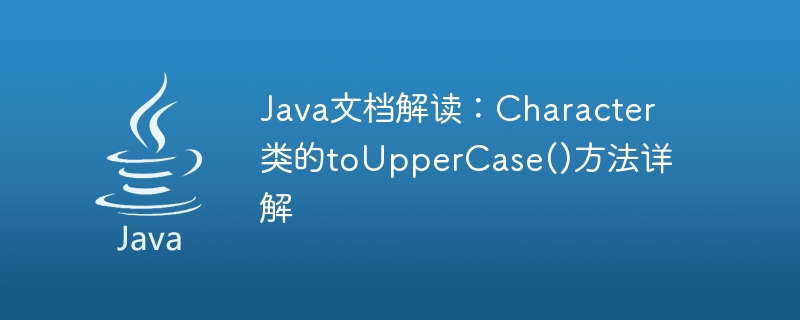

Interpretation of Java documentation: Detailed explanation of the toUpperCase() method of the Character class
In Java, the Character class is a wrapper class that represents a character. This class provides a series of methods for performing various operations and conversions on characters. This article will explain the toUpperCase() method of the Character class in detail and give specific code examples.
The toUpperCase() method is an instance method in the Character class, used to convert characters to uppercase. The definition of this method is as follows:
public static char toUpperCase(char ch)
This method receives a character parameter ch and returns an uppercase character. If the character is already in uppercase, the original character is returned.
The following is a simple sample code that demonstrates the use of toUpperCase() method:
char ch = 'a';
char upperCaseCh = Character.toUpperCase(ch);
System.out.println("原字符:" + ch);
System.out.println("大写形式:" + upperCaseCh);Run the above code, the following results will be output:
原字符:a 大写形式:A
From the above example As can be seen, the toUpperCase() method converts the lowercase letter 'a' to the uppercase letter 'A'. Now let's analyze the specific implementation principles.
First, the toUpperCase() method checks the Unicode code point value of the parameter ch. Unicode is an international standard for storing and processing text in computers. Every character has a unique Unicode code point.
If the Unicode code point value of parameter ch is in the lowercase letter range (i.e. 0x0061 to 0x007A), the toUpperCase() method will return a new character whose Unicode code point value is the code point of parameter ch Value minus 0x0020. This completes the conversion from lowercase letters to uppercase letters.
If the Unicode code point value of parameter ch is not within the lowercase letter range, the toUpperCase() method will return the parameter ch itself. This means that this method does not do any conversion for characters that are already uppercase.
It should be noted that the toUpperCase() method can only operate on a single character. If you need to convert all characters in a string, you can do this by iterating through each character in the string and calling the toUpperCase() method one by one.
The following is a sample code that demonstrates how to convert all characters in a string:
String str = "hello, world!";
String upperCaseStr = "";
for (int i = 0; i < str.length(); i++) {
char ch = str.charAt(i);
char upperCaseCh = Character.toUpperCase(ch);
upperCaseStr += upperCaseCh;
}
System.out.println("原字符串:" + str);
System.out.println("大写形式:" + upperCaseStr);Run the above code, the following results will be output:
原字符串:hello, world! 大写形式:HELLO, WORLD!
From the above As can be seen from the example, by looping through each character in the string and calling the toUpperCase() method one by one, we successfully converted all characters in the string to uppercase.
To sum up, the toUpperCase() method is a very practical method in the Character class, which can easily convert characters to uppercase. Through the interpretation and sample code of this article, I believe that readers have a deeper understanding of this method and can flexibly apply it in actual Java programming.
The above is the detailed content of Java documentation interpretation: Detailed explanation of the toUpperCase() method of the Character class. For more information, please follow other related articles on the PHP Chinese website!
 What are the commonly used DNSs?
What are the commonly used DNSs?
 How to use shift backdoor
How to use shift backdoor
 How to solve the problem of no internet access when the computer is connected to wifi
How to solve the problem of no internet access when the computer is connected to wifi
 Detailed explanation of nginx configuration
Detailed explanation of nginx configuration
 what is vb program
what is vb program
 What is the difference between ibatis and mybatis
What is the difference between ibatis and mybatis
 How much is one Bitcoin in RMB?
How much is one Bitcoin in RMB?
 How to use frequency function
How to use frequency function




